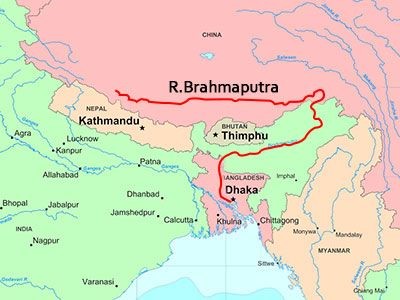As the city that claims to be the center of Assamese culture, Tezpur is underwhelming. You can cover most of the sights—a couple of temples and the picturesque Cole Park with its artificial lake--comfortably in half a day. The top tourist attraction is Agnigarh--in Sanskrit, the fortress of fire—on a hillock overlooking the Brahmaputra.
Stories from Hindu mythology tend to be long and involved, with many characters and sub-plots, so I’ll give you the short soapy version. Usha, daughter of Banasura, the thousand-armed king of central Assam, fell in love with Aniruddha, grandson of Lord Krishna. As relationships go, this was a non-starter, because Banasura was a devotee of Krishna’s sworn enemy, Shiva. Banasura tied up Aniruddha in a mess of snakes and packed Usha off to the Agnigarh fortress which was surrounded by a ring of fire. A bloody war between the forces of Krishna and Shiva—a scene vividly depicted in stone sculptures on the hillock—followed. Wise Lord Brahma stepped in, told them both to behave, and brokered the deal which ended with Banasura agreeing to the marriage. From the legendary battle, Tezpur earned the name of “city of blood.”
After a steep ascent on a hot, sticky day and a heavy dose of Hindu mythology, Stephanie and I needed lunch and a less taxing afternoon schedule. We decided on the city museum, housed in a British colonial-era bungalow, where we hoped to find AC along with the sculptures, crafts and Ahom-era cannons. There was no one on duty at the ticket office, so we entered the garden and looked for the entrance. On a covered stage near the gate, a small group of men had gathered for a ceremony around a makeshift altar with an offering bowl, incense sticks and framed photographs. I approached them.
“Is this the entrance to the museum?”
“Sorry, it’s closed today,” one man replied. “We’re celebrating the birthday of Bhupen Hazarika. Would you like to join us?”
This was not the first time I had heard the name of Hazarika, the much-revered artist and musician who literally put Assam on India’s modern cultural map. He was a singer, composer, lyricist, poet and film-maker, widely credited with introducing the culture and folk music of Assam and northeast India to Hindi cinema at the national level. He was also a tireless campaigner for social justice.
In 1935, nine-year-old Hazarika moved to Tezpur with his family. His public rendition of a classical Assamese devotional song, taught to him by his mother, caught the attention of the playwright and pioneer Assamese filmmaker Jyoti Prasad Agarwala and the artist and revolutionary poet Bishnu Prasad Rabha. Under their patronage, Hazarika recorded his first song at a Kolkata studio in 1936 and went on to sing in a 1939 Agarwala film. Meanwhile, he started writing his own songs.
In 1949, after earning an MA in Political Science and working briefly for All India Radio, Hazarika won a scholarship to Columbia University in New York. He completed his Ph.D. in mass communication in 1952. In New York he became friends with the African-American singer, actor and civil rights activist Paul Robeson. The imagery, theme and melody of one of Hazarika’s most famous songs, Bisitirno Paarore (On Your Wide Banks), was heavily influenced by Robeson’s rendition of Ol’ Man River in the 1936 movie version of the musical Show Boat. Oscar Hammerstein II’s lyrics to Ol’ Man River contrast the struggles of African-Americans with the endless, uncaring flow of the Mississippi River. In Hazarika’s version, the Mississippi becomes the Brahmaputra, flowing silently through a world of suffering and moral decay:
Bistirna paarore (On your wide banks)
Axonkhya jonre (That are home to countless people)
Hahakar xuniu (In spite of hearing their anguished cries)
Nixobde nirobe (So silently and unmindfully)
Burha luit tumi (Oh you, Old Luit [Another name for Brahmaputra])
Burha luit buwa kiyo? (How can you flow?)
After a brief spell of university teaching, Hazarika established himself in Kolkata as a music director and singer. He made several award-winning Assamese films, composed scores for Bengali films and in his later life for Hindi films. As a singer, he was famous for his baritone voice and diction. As a lyricist, he was known for poetic compositions and social and political messages. His songs, including Bisitirno Paarore, were translated into Bengali and Hindi. Hazarika dabbled in politics and for five years served as a representative to the Assam Legislative Assembly, but he always saw his music and films as the most effective forums for social action.
By the time he died in November 2011 at age 85, his fame had spread far beyond his native Assam. An estimated half a million mourners attended his funeral in Guwahati, the state’s commercial capital; a monument opened four years later is now a place of pilgrimage. Fittingly for the artist who composed an ode to a river, Hazarika’s name is on India’s longest bridge, opened in May 2017 by Prime Minister Narendra Modi. More than five miles long, it spans a major tributary of the Brahmaputra, the Lohit, linking Assam and Arunachal Pradesh, saving 100 miles and five hours in travel time between the states.
Stephanie and I joined the group, which included two writers and a film maker, on the stage, lit incense sticks and scattered lotus petals on the altar. There were short tributes to Hazarika, then the group sang one of his songs. Afterwards, we chatted and thanked them for making us part of the ceremony. “Please wait a few more minutes,” one insisted. Soon, one member of the group who had slipped away entered through the gate carrying a gamosa, the traditional Assamese scarf, a white rectangular piece of cloth with a red border on three sides and red woven motifs on the fourth. I stood, feeling humble, while two others draped it around my neck.







